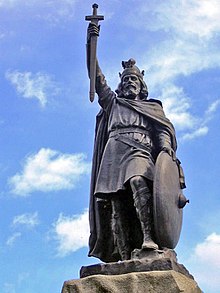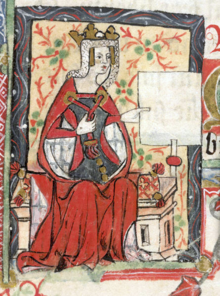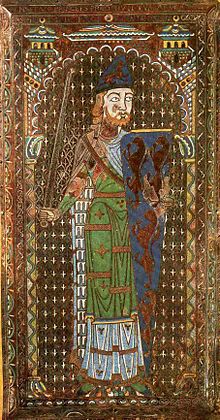Ceolwald from Wessex
Ceolwald von Wessex (fl. Around 650) was an Anglo-Saxon prince from the Gewissæ tribe , who had been the kings of Wessex since Cerdic, King of Wessex (519-534) . Ceolwald, who comes from the older line of the house, illustrates with his descendants not only the erratic succession to the throne in the Kingdom of Wessex, where his line has been ousted by power several times for decades, but also the continuity of the rule of his descendants, not just everyone else Lines in Wessex survived, but gained European importance as they rose to the first dynasty of the Kings of England , ranging from King Egbert of Wessex († 839) to Eduard the Confessor , who died in 1066.
Even after the male line was extinguished, his descendants in the female line remained important, as they were often viewed as the basis of the legitimacy of the succession to the throne in England, so that changing dynasties each depend on the continuity of the descendants in the female line - and thus indirectly on Cerdic and Ceolwald - called to justify their claims to the throne. The houses Plantagenet , Tudor , Stuart , Hanover , Saxe-Coburg and Gotha and Windsor and thus currently Queen Elisabeth II are among the descendants of Prince Ceolwald. His example illustrates that sometimes it can be more important to survive than to rule.
origin
Ceolwald came from the House of the Kings of Wessex , which is derived from Cerdic († 534/554), who, according to the Anglo-Saxon Chronicle , came to England in 495 with 5 ships and in 519 founded the Kingdom of Wessex.
Ceolwald was a great-grandson of Ceawlin King of Wessex (560-592) (who was a great-grandson of Cerdic) who, according to the Anglo-Saxon Chronicle, in 577 defeated the British kings Conmail, Condidan and Farinmail and Gloucester at the Battle of Deorham (Dyrham near Bath ) , Conquered Cirencester and Bath. After Beda Venerabilis and according to the Anglo-Saxon Chronicle, Ceawlin was the second ruler who ruled as " Bretwalda ", ie ruler of Britain , but in fact he was only the overlord of the Saxon rulers in southern Britain. It is known from the Anglo-Saxon Chronicle that Ceowald's grandfather Cutha / Cuthwine fought with his father King Ceawlin in the Battle of Deorham against the British in 577. Cutha, however, could not succeed his father as King of Wessex, as he was defeated and expelled in 592 by his nephew Ceol (also called Ceolric) († 597) in the battle of Woden's Barrow in Wiltshire. Ceolwald's grandfather Cutha therefore lived in exile for decades.
No biographical data is available about Ceolwald's father Cuthwulf (also called Cutha) (fl. 592 - 648). He should not be confused with his great-uncle Cutha / Cuthwulf of the same name, who, according to the Anglo-Saxon Chronicle 571, was victorious in the Battle of Bedcanford against an army of the British and conquered a number of cities, and father of the kings Ceol († 597) and Ceolwulf ( † around 611) from Wessex.
Life
No details are known about the life of Prince Ceolwald. He is mentioned twice in the Anglo-Saxon Chronicle. On the one hand by being named as the ancestor of King Ina of Wessex in the year 688, and on the other hand in the year 854, when he was named King of Wessex († 858) among the ancestors of Æthelwulf . His fate, however, illustrates the unpredictability of the succession to the throne in the Kingdom of Wessex, which did not follow any rigid rules - such as the primogeniture - but pragmatically fell to the most capable or most ruthless of the descendants of the ancestor of the dynasty, Cerdic, whereby his descendants only fell in the shadow of the dynasty for decades Crown lived, but ultimately rose to become a major European dynasty. Ceolwald could hardly hope to ever wear the crown of Wessex, since before his birth the important rule of his ancestor, the third king of Wessex, King Ceawlin, 591 through his nephew Ceol († 594/597), a son of Ceolwald's brother Cutha / Cuthwulf was ended by a military victory and the crown of Wessex subsequently remained in the possession of the descendants of Cuthwulf for several generations until 673, whereby Ceolwald and his descendants remained in the shadow of their cousins' rule for 82 years.
Aftermath
Ceolwald's aftermath is due to his descendants. Because it turned out that the marginalized line of Prince Ceolwald physically survived the other lines and after decades of waiting temporarily gained the crown of Wessex and after further decades on the edge finally took over the rule in Wessex and through a number of important rulers of England went down in history as one of the most important European dynasties. The first approach of the Ceowald line to the crown of Wessex did not take place until 685, when Caedwalla , a descendant of King Ceawlin - and great-nephew of Prince Ceolwald - came to the throne of Wessex as the 11th king. However, he ruled for only three years, resigned himself and sought salvation in Rome, where he was baptized by Pope Sergius I in 688 and died soon after in Rome.
Descendants of the male line
This was followed in 688 by Ceolwald's first descendant on the throne of Wessex, his grandson Ine († after 726 in Rome) as the 12th King of Wessex, an important ruler who founded the Glastonbury Abbey .
Then 76 years passed, in which none of Ceolwald's descendants wore the crown of Wessex, since between 726 and 802 distant - or alleged - descendants of the progenitor Cerdic ruled as kings of Wessex. These were the kings Æthelheard († 740), Cuthred († 756), Sigeberht († 757), Cynewulf († 786) and Beorhtric († 802), whose exact ancestry from King Cerdic cannot be determined from the Anglo-Saxon Chronicle .
After this long period in the shadow of power, Egbert von Wessex, a descendant of the 6th generation of Ceolwald, came to the throne of Wessex in 802, who also succeeded in gaining supremacy over all other Anglo-Saxon rulers in south-east England from 825 and therefore as is considered the first king of England and was called the 8th "Bretwalda" (ruler of Britain) by Beda Venerabilis. From then on, 15 kings of England from the direct descendants of Prince Ceolwald ruled for over 200 years - including Alfred the Great (871-899) and Edward the Elder (899-924), who was ruled by Ragnall and others Ímair (Reginald I. King of York) († 921), Constantine of Scotland († 952) and Owain ap Dyfnwal (fl. 934), the King of the British in Strathclyde was recognized as overlord until King Edmund Eisseite , who died in 1016.
After the interlude of the Danes, who seized power in England in 1013 with King Sven Gabelbart , Eduard the Confessor, another descendant of Ceolwald's male line, came to the throne of England from 1042 to 1066. After the death of Harald II. Godwinsson in the Battle of Hastings , Ceolwald's Edgar Ætheling († around 1125) was the last male descendant to claim the crown as heir of his grandfather Edmund Eisseite and was on October 15, 1066 in London by the Witenagemot , the assembly Anglo-Saxon clergy and secular dignitary, elected King of England, but not crowned. At the beginning of December, however, he had to submit to Wilhelm the Conqueror .
Descendants of the female line
However, this in no way meant the end of the dynastic role of Ceolwald's descendants, as this continued in the female line and became the basis of legitimacy in the English line of succession.
This female line is based on Margareta († 1093), the sister of the last - uncrowned - Anglo-Saxon king from the line of Prince Ceolwald, Edgar Ætheling, through whom five dynasties were married in three generations. This is because Margaret - who was later venerated as a saint - around 1069 Malcolm III. "Canmore", the King of Scots married, whose daughter Edith of Scotland , married in 1100 Henry I "Beauclerc", of England, the younger son of King William the Conqueror , from the Norman dynasty of the Rollonids , who from 1100 to 1135 as King of England ruled.
Her daughter Matilda of England married Emperor Heinrich V of the Salier family in 1114, making her Empress of the Holy Roman Empire from 1114 to 1125 and, through his sister Agnes von Waiblingen, both with the Staufer (Duke Friedrich I of Swabia ) as well as with the Austrian Margrave Leopold III. Was related by marriage to “the saint” from the house of the Babenberger .
In her second marriage, Mathilde married Geoffrey "Plantagenet" Count of Anjou , Touraine and Maine in 1127 and thus became the ancestor of the Plantagenet family.
The House of Plantagenet became John of Gaunt, 1st Duke of Lancaster ancestor of the House of Beaufort , Margaret Beaufort (1443-1509) , a daughter of John Beaufort, 1st Duke of Somerset († 1444), the mother of King Henry VII. Tudor was, which means that the House of Tudor is also one of the descendants of Ceolwald, as were the Scottish-English monarchs from the House of Stuart, since James I, King of England and Scotland, was a son of Margaret Tudor († 1541), the older sister of King Henry VIII of England was. William III. von Orange Nassau King of England (1689–1702) also counts among the descendants (via his mother Maria Henrietta Stuart ), as does the House of Hanover (Braunschweig-Lüneburg), which has ruled in Great Britain since 1714 (via Elisabeth Stuart († 1662), the grandmother of King George I (+1727)).
Queen Victoria (ruled 1837–1901) transferred this inheritance from the House of Hanover as the wife of Prince Albert of Saxe-Coburg and Gotha to the British line of the House of Saxe-Coburg and Gotha, which was called House Windsor from 1917 onwards. Ultimately, Queen Elizabeth II of Great Britain descended from Ceolwald von Wessex, as did a very large number of ordinary people.
Marriage and offspring
Fafertach (fl. 620 - 644), daughter of Prince Fenguins of Mumhan ( Munster in Ireland ), or Gwynhafar of Dumnonia, a daughter of King Clemen ap Bledric, who lived around 613 to 633 , are occasionally mentioned as the wife of Ceolwald - without proof ruled as King of Dumnonia (in south-west England).
progeny
-
Cenred , (fl. 670/76 - 705/717) son of Ceolwald Unter-King in Dorset in the Kingdom of Wessex, temporarily ruled alongside his son King Ine, as he appears in 692 with the title King of the West Saxons.
- Ine King of Wessex (688-726); † after 726 in Rome, married to Æthelburg (Wessex) († 740) who was referred to in later sources as the sister of Ines' successor, King Æthelheard. (no known offspring)
- Ingild, (son); † 718
- Eoppa
- Eafa He was believed to have been married to an heiress from the House of the Kings of Kent .
-
Ealhmund King in Kent 784/786.
- Egbert of Wessex, King of Wessex 802, is considered the first King of England as he was overlord of most of the other rulers in England from 825 onwards. († 839) closer ancestor of the Anglo-Saxon kings of England.
-
Ealhmund King in Kent 784/786.
- Eafa He was believed to have been married to an heiress from the House of the Kings of Kent .
- Eoppa
-
Cuthburh of Wessex , (fl. 700 - 718. Through her marriage around 695 to Aldfrith, King of Northumbria (685/86 - 704/5) † December 14, 704/705) she became Queen of Northumbria , and later separated from her husband ; founded and directed as abbess a Benedictine convent in Wimborne Minster . She is venerated as Saint Saint Cuthburga in the Catholic Church . Feast day September 3rd
- Osred I of Northumbria (* around 696/97 - 716) succeeds as a minor as King of Northern Humbria (705 - 716)
- Osric King of Northumbria (718-729) † May 9, 729
- Offa † around 750
- Osanna of Northumbria, known as Saint Osanna of Jouarre (* around 698, † 750) She is only mentioned by Geraldus Cambresensis († 1223). She fled to Brittany, became an "incluse" (walled-in nun) and - without formal canonization - venerated as a saint in the Catholic Church . Festival day: June 18.
- Cwenburh / Cwenburga von Wessex, fl. 716 succeeds her sister as abbess of Wimborne.
swell
- Anglo-Saxon Chronicle , online in Project Gutenberg (English)
- Beda Venerabilis , Historia ecclesiastica gentis Anglorum (Church history of the English people) (in English) sourcebooks.fordham.edu
literature
- Burke's Guide to the Royal Family. (= Burke's Genealogical Series ). Burke's Peerage, London 1973, ISBN 0-220-66222-3 , p. 187.
- Michael Hicks: Who's Who in Late Medieval England (1272–1489). Shepheard-Walwyn, ISBN 0-85683-125-5 .
- DP Kirby: The Earliest English Kings Unwin Hyman, London 1991, ISBN 0-04-445692-1 .
- Jiří Louda & Michael Maclagan: Les Dynasties d'Europe. Bordas 1984, ISBN 2-04-012873-5 .
- Sir Charles Oman: England before the Norman Conquest. 8th edition. Methuen & Co, London 1938.
- Alison Weir: Britain's Royal Families, The Complete Genealogy. The Bodley Head, 1989, ISBN 0-370-31310-0 , p. 3.
- Ann Williams, Alfred P Smyth, DP Kirby: A Biographical Dictionary of Dark Age Britain. England, Scotland and Wales, c. 500 - c. 1050. Seaby, London 1991, ISBN 1-85264-047-2 .
- Barbara Yorke : Kings and Kingdoms of early Anglo-Saxon England . Routledge, London / New York 2002, ISBN 0-415-16639-X , PDF (6.2 MB)
Web links
- FMG, Medieval Lands, Cenred in Foundation for Medieval Genealogy
Remarks
- ↑ See Wikipedia in English article Ceolwald of Wessex
- ↑ The further descendants result from the entry in the Anglo-Saxon Chronicle for the year 854, where the ancestors of Æthelwulf King of Wessex († 858) via Ingild, Cenred, Ceolwald to Cerdic and further to Wotan and even going back to Adam are given.
- ↑ Geraldus Cambresrensis, Itinerary of Bishop Baldwin through Wales II. 2
Individual evidence
- ^ Barbara Yorke: Kings and Kingdoms of Early Anglo-Saxon England. Seaby, London 1990, ISBN 1-85264-027-8 , family tree 16, p. 134.
- ↑ DP Kirby: The Earliest English Kings Unwin Hyman. London 1991, ISBN 0-04-445692-1 pbk, family tree in Appendix 3 (p. 222)
- ^ A b Barbara Yorke: Kings and Kingdoms of Early Anglo-Saxon England. Seaby, London 1990, ISBN 1-85264-027-8 , p. 135.
- ^ Anglo-Saxon Chronicle. A and E, 577.
- ↑ Beda Venerabilis, Historia ecclesiastica gentis Anglorum II, 5
- ^ Anglo-Saxon Chronicle for the year 827
- ^ Barbara Yorke: Kings and Kingdoms of Early Anglo-Saxon England. Seaby, London 1990, ISBN 1-85264-027-8 , p. 132.
- ↑ Michael Swanton: The Anglo-Saxon Chronicle. Routledge, New York 1996, ISBN 0-415-92129-5 , pp. 18,19.
- ^ Burke's Guide to the Royal Family. (= Burke's Genealogical Series ). Burke's Peerage, London 1973, ISBN 0-220-66222-3 , p. 187.
- ^ Barbara Yorke: Kings and Kingdoms of early Anglo-Saxon England . Routledge, London / New York 2002, ISBN 0-415-16639-X . PDF (6.2 MB) , family tree on page 149, p. 134 in the text
- ^ Barbara Yorke, Kings and Kingdoms of Early Anglo-Saxon England. Notes on family tree 16 on p. 134.
- ^ A b Alison Weir: Britain's Royal Families, The Complete Genealogy. The Bodley Head, 1989, ISBN 0-370-31310-0 , p. 3.
- ^ Burke's Guide to the Royal Family. (= Burke's Genealogical Series ). 1st edition. Burke's Peerage, London 1973, ISBN 0-220-66222-3 , p. 189.
- ^ Burke's Guide to the Royal Family. (= Burke's Genealogical Series ). 1st edition. Burke's Peerage, London 1973, ISBN 0-220-66222-3 , p. 193.
- ^ Jiří Louda, Michael Maclagan: Les Dynasties d'Europe. Bordas 1984, ISBN 2-04-012873-5 , Tableau 5
- ^ Jiří Louda, Michael Maclagan: Les Dynasties d'Europe. Bordas 1984, ISBN 2-04-012873-5 , Tableau 7.
- ^ Jiří Louda, Michael Maclagan: Les Dynasties d'Europe. Bordas 1984, ISBN 2-04-012873-5 , Tableau 8; 9.
- ^ Anglo-Saxon Chronicle for the year 688
- ↑ Patrick Wormald: Ine. In: Oxford Dictionary of National Biography . Oxford University Press, 2004.
- ↑ Barbara Yorke: Ine. In: Lapidge et al. (Ed.): The Blackwell Encyclopaedia of Anglo-Saxon England . Wiley-Blackwell, Oxford et al. 2001, ISBN 0-631-22492-0 , pp. 251-252.
- ↑ Anglo-Saxon Chronicle for the year 718
- ^ Anglo-Saxon Chronicle for the year 855
- ^ Alison Weir: Britain's Royal Families, The Complete Genealogy. P. 3, 4.
- ↑ Anglo-Saxon Chronicle, years 705 718
- ^ Foundation for Medieval Genealogy fmg.ac , Burke's, p. 187.
- ↑ Anglo-Saxon Chronicle 705, 716
- ↑ Osric 5 in Prosopography of Anglo-Saxon England
- ↑ DP Kirby: The Earliest English Kings. Routledge, London / New York 2000, ISBN 0-415-24211-8 , pp. 143, 147.
- ^ Anglo-Saxon Chronicle, year 718
| personal data | |
|---|---|
| SURNAME | Ceolwald from Wessex |
| BRIEF DESCRIPTION | Prince of Wessex |
| DATE OF BIRTH | 7th century |
| DATE OF DEATH | 7th century |






